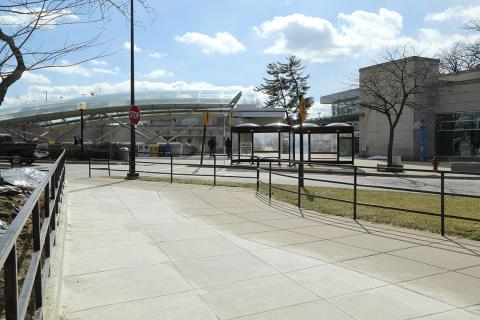Capital Bikeshare Coming to Campus

Photo: Bill Branson
It’s a crisp, clear day, perfect for a bike ride on your lunch break. But your bicycle is at home.
Well, there’s a new option coming to satisfy your urge to pedal around in the fresh air. Soon you can rent a bike whenever you want, right by the Medical Center Metro station.
The new Bikeshare station, with 10 bikes and 19 bike docks, will sit on the island between the Metro entrance and the Kiss and Ride parking lot. You’ll be able to grab a bike and cycle over to a meeting, traverse the 3.25-mile bike path around campus, run some errands or ride into downtown Bethesda to grab a bite. You can return the bike to any of the more than 350 Bikeshare stations across the greater Washington area.
“It’s an opportunity to access transit, get around near work, ride around at lunch hour and get some exercise,” said Gail Tait-Nouri, manager for pedestrian and bicycle projects for the Washington Metropolitan Area Transit Authority (WMATA).
Sponsored by the Montgomery County department of transportation and Capital Bikeshare, in cooperation with NIH and WMATA, the new station is one of more than 50 stations across Montgomery County. There are several around nearby Battery Park and another new one on Old Georgetown Rd. and Southwick St., across from Suburban Hospital.
To rent from Bikeshare, you first become a member. When you join—at any Bikeshare kiosk or at https://secure.capitalbikeshare.com/register—you receive a key to access a bike at any Bikeshare location, 24 hours a day. Choose from a 1-day, 3-day or 30-day pass or annual membership; the first 30 minutes of any trip is free for members.
So grab your helmet and you’re off. Montgomery County law requires anyone 18 or younger to wear a helmet, but every bicyclist should wear one, especially if riding alongside traffic. Also, check your surroundings and be careful at the new Bikeshare site.

Photo: Bill Branson
“That’s a busy area. Buses go through there regularly,” said Tait-Nouri. “We encourage people to look and be more vigilant as vehicles may not realize Capital Bikeshare has arrived.”
If you’re new to Bikeshare, or a novice cyclist, Tait-Nouri recommends contacting the Washington Area Bicyclist Association (www.waba.org), which offers bicycle training and safety classes.
A 2014 Bikeshare user survey showed most riders reported renting from Bikeshare to get around more easily and especially enjoyed the program’s one-way travel option. Most respondents also cited biking for the enjoyment of it and the exercise.
Riding a bike, even at a leisurely pace, is great exercise. NHLBI studies show that an hour of cycling (at about 5.5 mph) burns 460 calories in men and 370 calories in women. Just 30 minutes of moderate-intensity physical activity daily boosts energy and mood, reduces stress and tones muscles.
“Bikeshare is for NIH, Walter Reed and the entire community,” said Tony Clifford, chief engineer in NIH’s Office of Research Facilities. “It provides a hub for transportation. You can rent a bike when you get off of Metro or a bus. Now people who work or live nearby have an alternative form of transportation.”
Installing the station was expected to be a fairly fast process once the weather cooperated. In mid-February, once the cement was poured, the bike brackets and electronics were to be lowered by crane. Clifford, who co-chairs NIH’s Green Team, proudly points out that all nearby trees were preserved.
In addition to the exercise and sustainability, biking is just a convenient way to get around. NIH received a 2013 regional award for encouraging alternative commuting options. One of the first federal agencies to offer a bicycle subsidy program, NIH also is still riding out the success of its Bike to Work Day each spring. That is the NIH Bicycle Commuter Club’s signature annual event.
Tait-Nouri emphasized the role Montgomery County played in making the new Medical Center Bikeshare station a reality. “The county did all the legwork and paid for it,” she said. “Cost isn’t insignificant here. It’s a great public service.”
